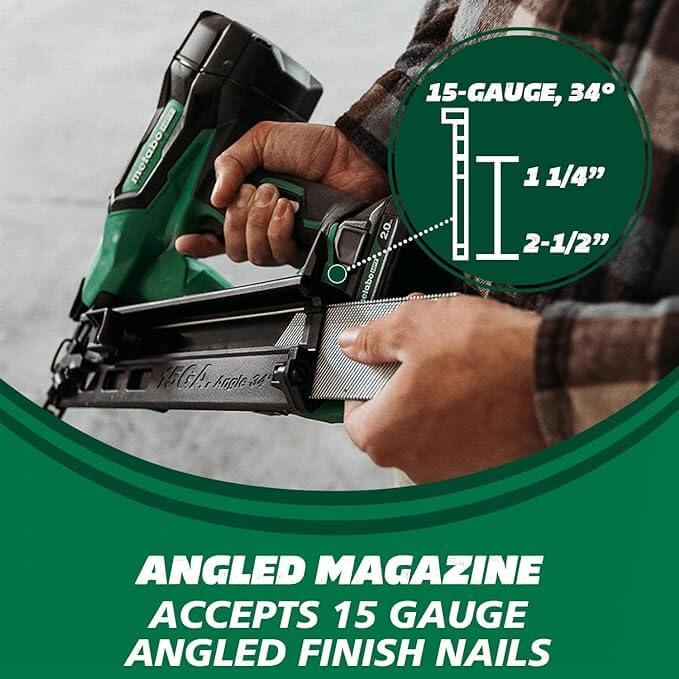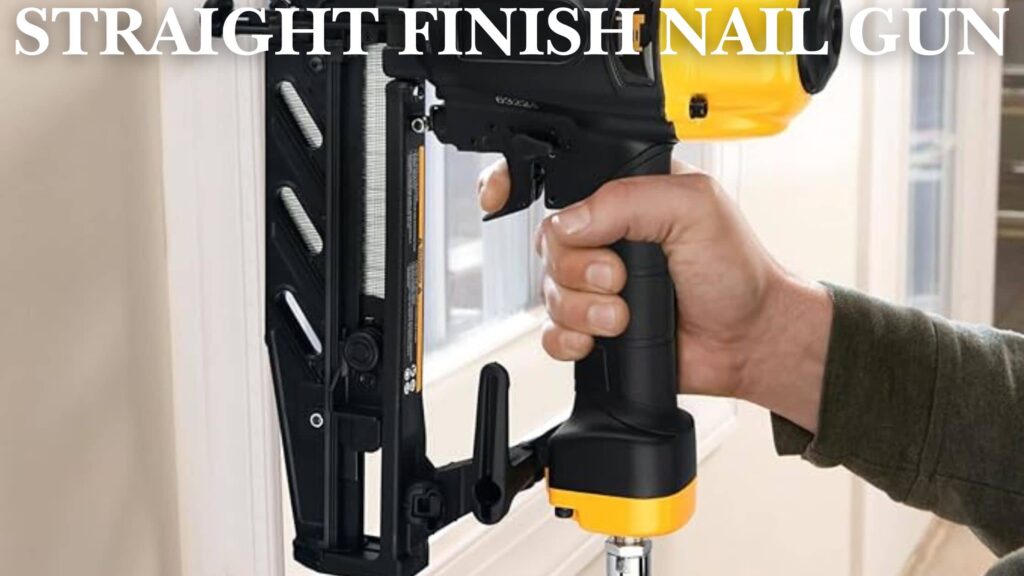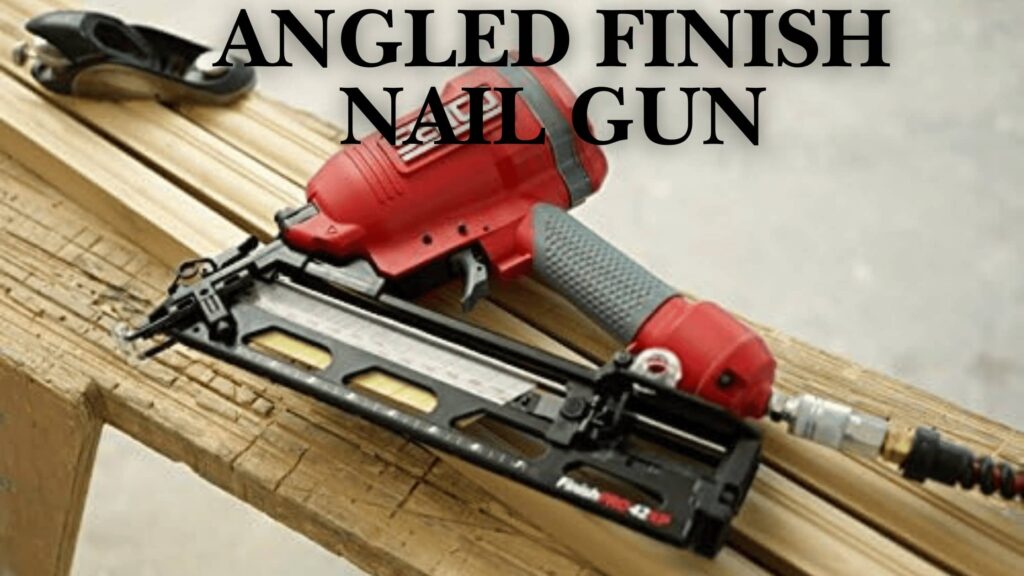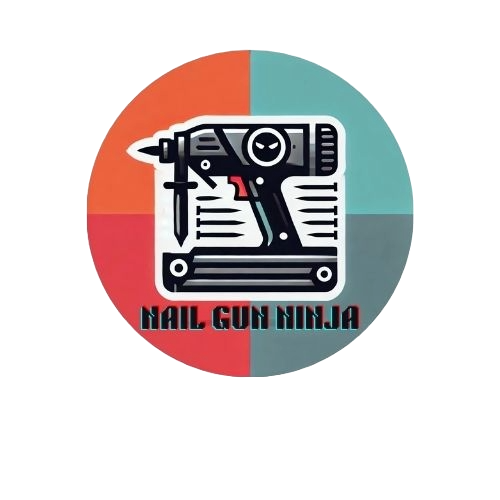Whether you are working on a DIY project or professional construction, having the right tools is essential for completing the job efficiently.
Let’s learn more about angled vs straight finish nailer so you can make an informed decision!
There are two main types of finishing nailers available in the market: angled finish nailers and straight finish nailers. Both have advantages and disadvantages you need to consider before purchasing.
Overview of Angled Finish Nailer vs Straight Finish Nailer
Both angled and straight-finish nailers help drive nails into various materials such as wood, fiber, plastic, and metal. However, their use and applications differ slightly. Here is a detailed overview of angled vs straight finish nailers:
Angled Finish Nailer

Angled finish nailers come with an angled magazine that allows you to place the nails at an angle.
The magazine is attached to the base of the nailer and angled towards the tip. This design makes it easier to work in tight spaces and corners. The shape of the nailer makes it more comfortable to grip and handle as well, which is ideal for long hours of work.
Nail Gauge
Most angled finish nailers use 15 or 16-gauge finish nails. The 15 gauge finish nails are thicker than the 16 gauge finish nails. 15 gauge is used in heavy-duty jobs, whereas 16 gauge is applicable in lighter works.
Angled Magazine
The nail magazine of this tool is angled. That’s why it is popular as angled finish nail guns. The angled magazine allows precise and detailed nailing in tight and corner spaces.
Ergonomic Design
These tools come with a comfortable design and compact size. It provides users anti-slip hand grip to use for a longer period.
Shape
The shape of angled finish nailers is more ergonomic and allows for a better grip. The shape also allows users to work in places that are difficult to reach such as corners, tight spaces, and edges.
Applications
Angled finish nailers are best suited for working in tight spaces, corners, and difficult-to-reach areas. Finish nailers can be used for a variety of applications such as baseboard works, cabinetry projects, crown moldings, and so on, if you want to know more dive in here.
Weight
The weight of angled finish nailers is well-balanced, making it easy to maneuver. It’s lighter than straight-finish nailers, which can be a big advantage if you’ll be using it for long periods.
Pros
- Easier to work in corners and tight spaces
- Versatile tool. Suitable for crown molding, baseboards, and cabinetry.
- More comfortable to grip and handle
- Strong nail holding. Uses thicker nails for more fastening.
Cons
- Nails can bend easily if not held properly
- A bit pricey
- Heavier weight, due to their design
- Limited nail compatibility compared to others
- Might be challenging for beginners
Straight Finish Nailer

As the name suggests, straight-finish nailers have a straight magazine that allows you to place the nails in a straight position.
This type of nailer uses smaller nails and has a straight magazine for storage. The attached magazine is located on the front of the nailer, which takes up extra space but is convenient.
The boxy shape of the straight nailer gives you a good grip and more control over the tool. It is also easier to balance, making it ideal for working on both larger and lighter projects.
Straight Magazine
The nail magazine of this tool is aligned straight with the body. It makes the tool easy to handle. This magazine especially designed for flat and flush nailing.
Power Options
It is available in both power options. Pneumatic and cordless models of these nail guns are available.
Adjustable Depth Settings
You can set how deep your nails will penetrate the materials. It reduces the risk of splitting a delicate wood material.
No-Mar Tip
This key feature protects the power tool from scratches and dents during operation. It allows you to have delicate trim work and aesthetic finishes.
Shape
The shape of the straight-finish nailer is boxy, which gives you a good grip and more control over the tool. However, it limits your visibility as well as your ability to work in corners and tight spots.
Applications
If you are working on lighter projects such as picture frames, door frames, and moldings, then a straight-finish nailer is a good choice. It can also be used for some heavier projects like construction and carpentry.
Weight
Straight finish nailers are on the heavier side making it a bit difficult to maneuver for long periods. However, the weight keeps the tool steady which makes it ideal for more delicate and precise work.
Pros
- Affordable
- Good grip and control
- Easy to balance
- Versatile nail compatibility.
- Provide excellent holding power for heavy woodworking
- Widely availability. 16 gauge straight finish nails are easily findable even at a cheaper price.
Cons
- A bit heavier
- Viewing angles are limited. This means limited access in tight and corner spaces
- Risk of surface damage and splitting such as thin trim or small moldings
- Not for High-End Work. In the case of high-end finishes angled finish nail guns are appropriate.
Key Differences: Finish Nailer Angled vs Straight
It’s easy to get confused because of a few reasons, such as Both are nailers, so they appear to do the same job; both use nails; and both have a similar design.
However, there are some big differences between these two types of nailers that you need to know about before deciding which one is right for your needs.
Let’s take a look at some of the key differences between angled vs straight finish nailers:
Shape
The first noticeable difference is the shape. Angled finish nailers are, well, angled. This gives them a slanted tip that makes it easier to get into tight spaces and corners.
On the other hand, straight-finish nailers have a more traditional design with a rectangular shape and a flat tip. This design makes it easier to use the nails on flat and level surfaces.
Nail Size
Another key difference between angled and straight finish nailers is the size of nails that they can accommodate. Both nailers can work with different sizes of nails. However, angled finish nailers are typically designed to work with bigger nails. This is because the slanted tip helps to guide the nail into the proper position.
Meanwhile, straight-finish nailers are better suited for smaller nails. This is because the flat tip can make it difficult to place the nail correctly if it’s too big.
Nail Capacity
The capacity of both angled and straight finish nailers can vary depending on the model. However, in general, most straight nailer magazines can only accommodate nails 16-gauge or higher.
On the other hand, angled finish nailers can typically accommodate both 16-gauge and 18-gauge nails. This gives you more options when it comes to choosing the right size of nail for your project.
Weight
A tool’s weight is always an important consideration, especially when you’ll be using it for extended periods.
When it comes to the weight of angled and straight finish nailers, there is very little difference. However, the weight of the tool can be a deciding factor for some people.
If you’re looking for a finish nailer that is on the lighter side, then you might want to go with angled finish nailers. These tools are typically around 3-4 pounds. On the other hand, straight-finish nailers tend to be a bit heavier, usually weighing in at around 4-5 pounds.
Applications
If you have to work in a tight space, it might be difficult to maneuver a straight finish nailer. An angled one would be a better choice as it will allow you to control the tool. This makes angled nailers ideal for corners, cramped locations, and other difficult-to-reach places.
On the other hand, straight-finish nailers are better suited for longboards, working on horizontal surfaces, or locations where there is not much space to maneuver the tool.
Comparison Chart | At a Glance:
| Characteristics | Straight Finish Nailer | Angled Finish Nailer |
| Visibility | Limited visibility | Has better visibility |
| Nails | Uses smaller nails | Uses bigger nails |
| Weight | Slightly on the heavier side | Slightly on the lighter side |
| Locations | Ideal for flat surfaces | Ideal for corners and tight spaces |
| Use cases | Larger boards, photo frames, basic residential use, thin boards, lighter projects, etc. | Corners, thicker boards, furniture building/repair, tighter location, etc. |
| Price | It’s on the cheaper side | It can be a bit pricy |
What is a Straight Finish Nailer Used For?
Powered nailers are among the most versatile and commonly used tools in any workshop. They come in a variety of shapes and sizes, each designed for specific tasks. Straight-finish nailers are one type of nailer commonly used for finish work and trim. They can also be used on baseboards as they deliver the right amount of power.
As the name suggests, these nailers shoot nails in a straight line, making them ideal for tasks that require precision.

Let’s find out more about the 16 Ga Straight Finish Nailer.
Working with thin and delicate materials
If you’re working with thin or delicate boards or trim, a straight-finish nailer is the best tool for the job. The precision that these nailers offer makes it easy to avoid damaging the material you’re working with. Since these tools use smaller nails, they’re also less likely to cause damage.
Attaching boards at 90-degree angles
Another great use for straight-finish nailers is when you need to attach boards at 90-degree angles. This is a common task when you’re working on trim or framing projects. The precision of these nailers makes it easy to get the nail in the perfect position, ensuring a strong and sturdy joint.
Larger projects
While straight-finish nailers are often used for smaller projects, they can also be used for larger ones. If you’re working on a larger board that requires many nails, a straight-finish nailer can help you get the job done quickly and efficiently. If you are using a lot of nails, it’s important to make sure that your nailer has a large enough magazine to accommodate them all, and straight-finish nailers tend to have larger magazines than angled-finish nailers.
Normal home repairs and projects
If you are working with photo frames, door frames, or anything else around the house that requires nails, a straight-finish nailer is the best tool for the job. These tools are designed for precision, making it easy to get the nail in the right spot without damaging your item. These nailers can also be used for delicate items that might be damaged by a larger nail.
What is an Angled Finish Nailer Used For?
Now when it comes to angled finish nailers, this tool is a bit more versatile than the straight one and can be used for a variety of tasks. While it’s still great for finish work and trim, angled finish nailers can also be used for other projects like installing baseboards, door frames, and more.
One of the biggest advantages of an angled finish nailer is that it gives you more maneuverability. This makes it easier to use in tight spaces and can help you avoid damaging your material.

Let’s find out more about the Angled Finish Nail Gun!
Ideal for working on corners
If you’re working on a project that requires you to attach trim or boards in a corner, angled finish nailers are the best tool for the job. The angle of the nailer makes it easy to get into tight spaces that a straight nailer couldn’t reach. The angled shape also allows more visibility so you can avoid any accidental damage.
Projects that require bigger nails
While straight-finish nailers are great for smaller projects, they might not be able to handle the bigger nails that some projects require. Angled finish nailers, on the other hand, can accommodate larger nails. This is ideal for tasks like installing baseboards or door frames where you need a little extra holding power.
Building furniture
Yes, angled finish nailers can even be used for some light carpentry work like building furniture. The versatility of these nailers makes them ideal for a variety of tasks, both big and small. Again the angled shape is handy as it makes it easy to work in tight spaces. You can also use it for furniture repairs and other projects around the house.
Tighter locations
Whether you’re working in a small space or trying to avoid damaging an adjacent piece of trim, angled finish nailers can give you the clearance you need to get the job done right. In contrast, straight-finish nailers might be too bulky for some tight situations.
Which is Better? Angled vs Straight Finish Nailers
There is no one short answer to this question as it depends on the project you’re working on.
If you’re doing something small and delicate, straight-finish nailers might be the better option. But if you need more maneuverability or are working with bigger nails, angled finish nailers are the way to go.
You don’t want to use a finish nailer that is too big or too small for your project as this can make the job more difficult and even cause damage. So it’s important to choose the right finish nailer for the task.
Conclusion
Both angled and straight-finish nailers are great tools for a variety of projects. It just depends on what you’re working on or your assigned projects. If you’re doing something small and delicate, go with straight-finish nailers.
But if you need more maneuverability or work with bigger nails, angled finish nailers are the way to go. So, your first and foremost duty is to consider your assigned tasks or projects and choose the finish nailers that are right for the job. It would be a wise decision above all! Keep nailing properly!!

